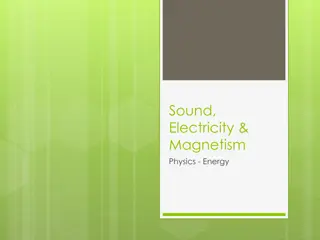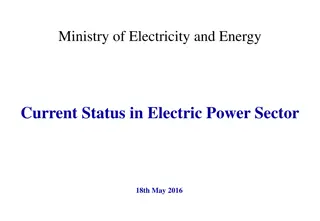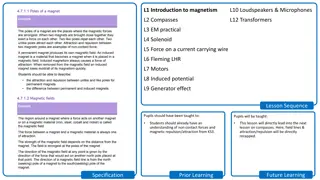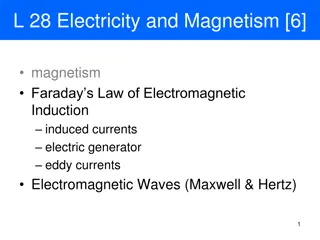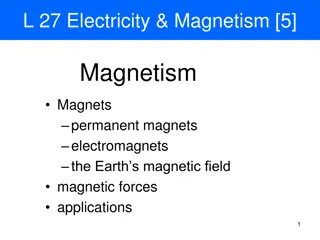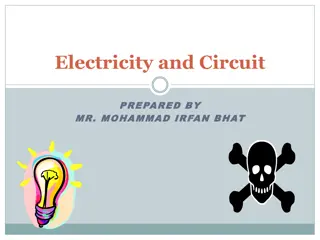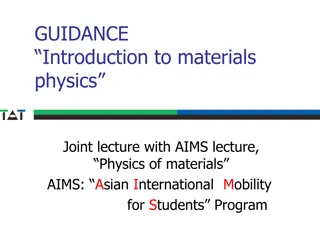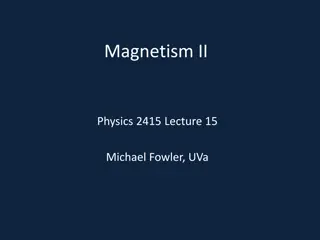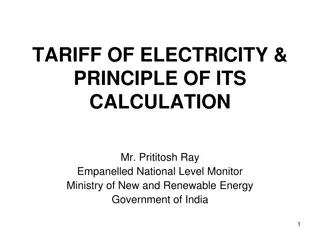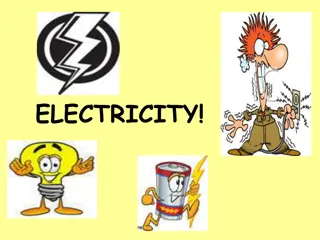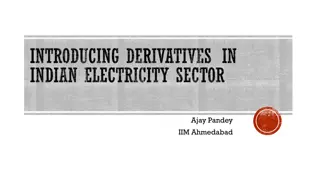Understanding Electricity and Magnetism: Test Review Questions Explained
Explore key concepts in electricity and magnetism through a series of test review questions. Topics covered include parallel circuits, series circuits, voltage distribution, circuit completion, and circuit configurations. Enhance your understanding of these fundamental principles with clear explanations and diagrams provided in the review.
Download Presentation

Please find below an Image/Link to download the presentation.
The content on the website is provided AS IS for your information and personal use only. It may not be sold, licensed, or shared on other websites without obtaining consent from the author. Download presentation by click this link. If you encounter any issues during the download, it is possible that the publisher has removed the file from their server.
E N D
Presentation Transcript
Electricity and Magnetism Electricity and Magnetism Test Review Test Review
Sal connected four light bulbs in a parallel circuit. If Sal adds another light bulb, what is true about the current in each bulb? A) The current decreased when a fourth bulb was added. The current in the four bulbs is much less than the current in three bulbs. B) The current in each bulb remained the same even though another bulb was added. C) The current in the fourth bulb is less than the current in the other three bulbs. D)
One advantage to using this form of circuit is that voltage available to each light remains constant regardless of the number of lights that are on. A) current drawn from the battery remains constant regardless of the number of lights that are on. B) resistance along the circuit remains constant regardless of the number of lights that are on. current drawn from the battery decreases as more lights are turned on. C) D)
A strand of 10 lights is plugged into an outlet. How can you determine if the lights are connected in series or parallel? Unscrew one light. If the other lights stay on, it's a series circuit. A) Unplug the strand. If the first light stays on, it's a series circuit. B) Unscrew one light. If the other lights turn off, it's a series circuit. C) Cut the strand in half. If the plugged in half stays on, it's a series circuit. D)
Look at the diagram. Emily needs to complete the circuit. What two points should be connected to complete the circuit and make the bulb glow? A) Points 2 and 3 B) Points 1 and 4 C) Points 2 and 4 D) Points 1 and 3
Each light switch in the classroom allows you to turn on one row of lights. What conclusion can you make about how the rows of lights are connected? The rows must be hooked up in parallel or only one row could be turned on at a time. The rows must be hooked up in series or all the rows of lights would either turn on or off. The rows must be hooked up in parallel or all the rows of lights would either turn on or off. The rows must be hooked up in parallel or all the rows of lights could only be controlled by a single switch. A) B) C) D)
Two circuits are created using two identical light bulbs. In the circuit A, the bulbs are hooked up in series. In circuit B, the light bulbs are hooked up parallel. Each circuit is powered by a 6-volt battery. Which statement or observation would not be supported by the two two circuits? A)The current in the circuit A would be less. B)The light bulbs in the circuit B would be brighter. C)The light bulbs in circuit B are equal in brightness. D)If one light burns out in circuit A, the other bulbs gets brighter.
An advantage of parallel circuits is that they A) stop transmitting all current if even one resistor breaks. B) form a single path through which the current flows. C) allow current to flow even if some paths are cut. D) divide the voltage evenly between all resistors.
A series circuit connects a single light bulb to a single power source. As more light bulbs are added to the circuit, what change is caused in the voltage to each bulb? A. Voltage increases as the number of lights added increases B. Voltage slightly increases as the number of lights added increases C. Voltage decreases as the number of lights added increases D. Voltage doesn t change as the number of lights added increases
Which graph BEST represents the change in light intensity along the circuit shown here as a fourth, fifth, and sixth light are added?
Your class decides to build a circuit to make a light bulb shine. When you are finished, you have a setup like the picture above. What role does the battery play in this circuit design? A) The battery works as the system's output. switch. B) The battery is the electrical power supply. C) The battery is the circuit's main conductor. D) The battery works as the system's electrical
A parallel circuit connects three light bulbs to a single power source. As each light bulb is turned on, which graph BEST represents the voltage to each light bulb?
What happens in this circuit if one of the light bulbs is unscrewed? A) The other bulb goes out. B) The other bulb stays lit. C) Current stops flowing in the circuit. D) The current path in the circuit is broken.
A fuse is used to protect electric circuits from too much electricity running through them. How should a fuse be hooked up with the components it is designed to protect? A) A fuse should be hooked up in series because all the current must flow through the fuse in a series circuit. B) A fuse should be hooked up in parallel because all the voltage must flow through the fuse in a series circuit. C) A fuse should be hooked up in parallel because all the current must flow through the fuse in a parallel circuit. D) A fuse should be hooked up in parallel because all the voltage must flow through the fuse in a parallel circuit.
An electrician is creating a wiring plan for a small house. He needs to create a plan that will allow the homeowners to turn off lights in one room without turning off the lights in another. What should he do to assure that each room's lights function independently of one another? A) He should wire each room in series with the next. B) He should wire each room in parallel with the next. C) He should make sure each room's lights provide the same resistance. D) He should wire the room with the most lights directly to the circuit breaker box.
When using a series circuit to connect four small light bulbs, which statement is MOST accurate? A) If one bulb fails, the other three can remain operational. B) The current passing through each bulb is the same. C) By adding more light bulbs in the series, it will draw less current from the power source. D) As more light bulbs are added in series, the brightness of the bulbs will stay the same.
Mark and Maria were cooking supper for their parents. They were using the electric frying pan, the toaster, and the burner on the electric stove. As they were cooking, the lights began to flicker, and then--surprise!--all the lights went out in the kitchen. "Oh no, our supper. The power went off in the kitchen!" cried Maria. "It's just a fuse," Mark commented. "I'll check the fuse box. We'll be cooking again in just a minute! When the electricity goes off as a result of a blown fuse or a flipped breaker, a(n) ____________ has been created and the electrical current is stopped. A) open circuit B) dead battery C) parallel circuit D) a blockage in the circuit
There is a single path for electrons. The current decreases when additional resistors are added. The current will be the same in each resistor. These statements BEST describe a(n) _____________ circuit. A) closed B) open C) parallel D) series
A light bulb will glow when electrons flow through it. As the electron flow increases, the brightness increases as well. A student hooks up two circuits containing three light bulbs in each circuit. In one circuit the lights are connected in series and in the other circuit the lights are hooked up in parallel. If you could only see the lights in the circuit and the wires were covered from view, how could you determine the type of circuit the lights are arranged in? A)If all the lights are equal brightness, it is a series circuit. B)If all the lights are equal brightness, it is a parallel circuit. C)Unscrew one light, if the others remain on it is a series circuit. D)Unscrew one light, if the others remain on it is a parallel circuit.
Chemical, potential energy is stored in a battery. The negative end of a battery is connected to a wire. The wire loops numerous times around a piece of steel. The wire returns to the positive end of the battery. What happens to the piece of steel? A) It begins to spin. B) It gains a negative charge. C) It gains a positive charge. D) It moves toward a piece of iron.
A table has several directional compasses, several lengths of wire, an iron nail, a battery, an ammeter, a light bulb, a permanent magnet, and a rubber eraser. A student is asked to design an experiment to prove that a moving charge will produce a magnetic field. From the items on the table, which items can be used together to design such an experiment? A) A battery, an iron nail, and a wire. B) A battery, a length of wire and a direction compass. C) a battery, a permanent magnet and a directional compass D) a permanent magnet, a length of wire and a directional compass.
A magnetic field is created by a charged particle that is A) balanced. B) motionless. C) moving. D) unbalanced.
The south pole of a bar magnet will repel A) a paper clip. B) iron filings. C) the south pole of another bar magnet. D) the north pole of another bar magnet.
Which property of magnets is being shown in the picture? A) Like poles and opposite poles repel. B) Like poles and opposite poles attract. C) Like poles repel and opposite poles attract. C) Like poles attract and opposite poles repel.
Magnets and electromagnets can both be used to pick up metal items like iron nails. Even though they are similar, there are differences between magnets and electromagnets. An example of one of these differences is that A) a magnet will pick up items that can't be picked up by an electromagnet. B) an electromagnet will pick up items that can't be picked up by an magnet. C) electromagnets have a set strength, while the strength of a magnet can be adjusted. D) magnets have a set strength, while the strength of an electromagnet can be adjusted.
Which pair of magnets will ATTRACT each other? A) B) C) D)
All of the arrows in the bar magnet are pointing in the same direction to represent that A) all of the metals are crystally aligned. B) all of the atoms are pointing in the same direction. C) all of the electricity is flowing in the same direction. D) all of the unpaired electrons spinning in the same direction.
Mr. Smith challenged his students to create an electromagnet that will pick up more paper clips than anyone else in the class. Timmy is very excited and begins to collect all of the necessary materials. He finds a D-cell battery, an iron nail, and a large roll of copper wire. What could Timmy do, using just these materials, to increase the strength of his electromagnet to pick up the maximum amount of paper clips? A) cut the iron nail in half to use as the core B) only attach the battery to one end of the nail C) increase the number of coils of copper he puts around the nail D) decrease the number of coils of copper wire he puts around the nail
In order to produce an electric current in a coil of wire, a magnetic field through the coil must be A) moving. B) negative. C) neutralized. D) positive.
Which set of magnets correctly shows us that like poles repel?
A table has several directional compasses, several lengths of wire, an iron nail, a battery, an ammeter, a light bulb, a permanent magnet, several metal paper clips and a rubber eraser. A student is asked to build and demonstrate a working temporary magnet. From the items on the table, which items can be used together to accomplish this task? A)A battery, an iron nail, a wire and several paper clips will accomplish this task. B)An ammeter, an iron nail, a wire and several paper clips will accomplish this task. C)A battery, a wire, a permanent magnet and several paper clips will accomplish this task. D)A battery, an iron nail, a permanent magnet and several paper clips will accomplish this task.
Which change would result in a stronger electromagnet? A) Reducing the number of batteries B) Increasing the voltage of the battery C) Substituting another metal for the iron core core. D) Decreasing the number of coils around the iron
Which method could have caused all of these arrows to point in the same direction? A) heating the bar gently over a long period B) rubbing the bar vigorously on top of some carpet or wool C) placing the bar in a strong magnetic field for a long time D) connecting one side of the bar to the positive terminal of a
Look at the picture of an electromagnet. Magnets and electromagnets can both be used to pick up metal items like iron nails. Although they are alike, there is a difference between magnets and electromagnets. An example of this is that increasing the current running through the electromagnet's wire will make it stronger. What is another difference? A)Increasing the amount of wire loops will increase the strength of an electromagnet. B)Increasing the amount of wire loops will increase the strength of a magnet. C)There is no other difference between electromagnets and magnets. D)Electromagnets are always stronger than regular magnets.
Lisa exposes an iron paper clip to a very strong magnet. She is now able to pick up other paper clips using her newly magnetized clip. What happens within the paper clip in order for it to become magnetized? A) The magnet randomizes the domains within the paper clip. B) Part of the strong magnet "rubs" off and joins to the paper clip. clip C) The strong magnet aligns the magnetic domains within the paper D) The strong magnet creates an electric force filed around the paper
Renaldo and Nasreen build an electromagnet by wrapping a wire around a nail and connecting the wire to both terminals of a battery. When they test the electromagnet, it can pick up 6 paper clips. Their teacher wants all groups to pick up at least 10 paper clips. What could Renaldo and Nasreen do to increase the number of paper clips their electromagnet picks up? A) make the wire longer B) remove the nail from the center of the wire C) increase the number of loops of wire around the nail D) spread the loops of wire apart on the nail so they do not touch
Describe what would happen to the arrows if this magnet were picked up and dropped numerous times. A) nothing B) the arrows would be removed C) the arrows would point in the opposite direction D) the arrows would point in a variety of directions
Suppose you connect a wire from the positive to negative terminal of a battery. Once this circuit is connected, all of the following items are put next to the wire, which one of them moves? A) compass needle B) a petri dish full of water C) small piece of aluminum foil D) a battery placed in the opposite direction
You can find electric power lines under the ground by looking for magnetic fields at ground level. This is best explained by which of these statements? A) All wires have magnetic materials in them. B) An electric current in a wire produces a magnetic field. C) The power company puts magnets to help find the power lines. D) The iron in the ground is disturbed by the power lines creating magnetic fields.
In the lab, Penny was able to turn an iron nail into a magnet simply by exposing the nail to a strong magnet. She later discovered that this worked because the strong magnet helped to align the magnetic domains within the nail. All BUT one treatment would demagnetize Penny's newly created magnet. That is A) heating it B) cooling it C) hammering it D) placing it in a solenoid with alternating current
How is an electromagnet different from a bar magnet? A) Only a bar magnet has a magnetic field. B) Only an electromagnet attracts materials made of iron. C) An electromagnet is temporary and is magnetic when a current flows through a wire wrapped around the core. D) A bar magnet is a temporary and is only magnetic when a current flows through a wire wrapped around the core.


